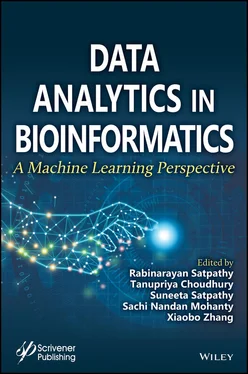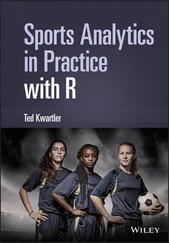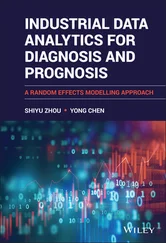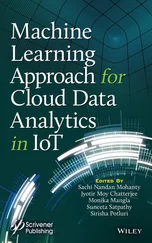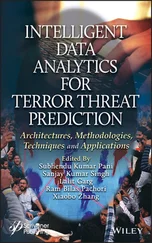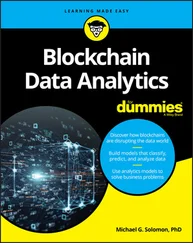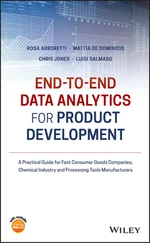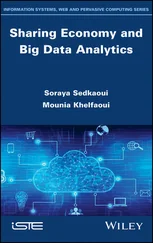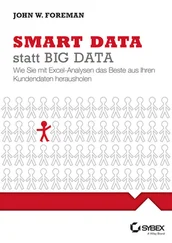1 Cover
2 Title Page
3 Copyright
4 Preface
5 Acknowledgement
6 Part 1: THE COMMENCEMENT OF MACHINE LEARNING SOLICITATION TO BIOINFORMATICS 1 Introduction to Supervised Learning 1.1 Introduction 1.2 Learning Process & its Methodologies 1.3 Classification and its Types 1.4 Regression 1.5 Random Forest 1.6 K-Nearest Neighbor 1.7 Decision Trees 1.8 Support Vector Machines 1.9 Neural Networks 1.10 Comparison of Numerical Interpretation 1.11 Conclusion & Future Scope References 2 Introduction to Unsupervised Learning in Bioinformatics 2.1 Introduction 2.2 Clustering in Unsupervised Learning 2.3 Clustering in Bioinformatics—Genetic Data 2.4 Conclusion References 3 A Critical Review on the Application of Artificial Neural Network in Bioinformatics 3.1 Introduction 3.2 Biological Datasets 3.3 Building Computational Model 3.4 Literature Review 3.5 Critical Analysis 3.6 Conclusion References
7 Part 2: MACHINE LEARNING AND GENOMIC TECHNOLOGY, FEATURE SELECTION AND DIMENSIONALITY REDUCTION 4 Dimensionality Reduction Techniques: Principles, Benefits, and Limitations 4.1 Introduction 4.2 The Benefits and Limitations of Dimension Reduction Methods 4.3 Components of Dimension Reduction 4.4 Methods of Dimensionality Reduction 4.5 Conclusion References 5 Plant Disease Detection Using Machine Learning Tools With an Overview on Dimensionality Reduction 5.1 Introduction 5.2 Flowchart 5.3 Machine Learning (ML) in Rapid Stress Phenotyping 113 5.4 Dimensionality Reduction 5.5 Literature Survey 5.6 Types of Plant Stress 5.7 Implementation I: Numerical Dataset 5.8 Implementation II: Image Dataset 5.9 Conclusion References 6 Gene Selection Using Integrative Analysis of Multi-Level Omics Data: A Systematic Review 6.1 Introduction 6.2 Approaches for Gene Selection 6.3 Multi-Level Omics Data Integration 6.4 Machine Learning Approaches for Multi-Level Data Integration 6.5 Critical Observation 6.6 Conclusion References 7 Random Forest Algorithm in Imbalance Genomics Classification 7.1 Introduction 7.2 Methodological Issues 7.3 Biological Terminologies 7.4 Proposed Model 7.5 Experimental Analysis 7.6 Current and Future Scope of ML in Genomics 188 7.7 Conclusion References 8 Feature Selection and Random Forest Classification for Breast Cancer Disease 8.1 Introduction 8.2 Literature Survey 8.3 Machine Learning 8.4 Feature Engineering 8.5 Methodology 8.6 Result Analysis 8.7 Conclusion References 9 A Comprehensive Study on the Application of Grey Wolf Optimization for Microarray Data 9.1 Introduction 9.2 Microarray Data 9.3 Grey Wolf Optimization (GWO) Algorithm 9.4 Studies on GWO Variants 9.5 Application of GWO in Medical Domain 9.6 Application of GWO in Microarray Data 9.7 Conclusion and Future Work References 10 The Cluster Analysis and Feature Selection: Perspective of Machine Learning and Image Processing 10.1 Introduction 10.2 Various Image Segmentation Techniques 10.3 How to Deal With Image Dataset 10.4 Class Imbalance Problem 10.5 Optimization of Hyperparameter 10.6 Case Study 10.7 Using AI to Detect Coronavirus 10.8 Using Artificial Intelligence (AI), CT Scan and X-Ray 274 10.9 Conclusion References
8 Part 3: MACHINE LEARNING AND HEALTHCARE APPLICATIONS 11 Artificial Intelligence and Machine Learning for Healthcare Solutions 11.1 Introduction 11.2 Using Machine Learning Approaches for Different Purposes 11.3 Various Resources of Medical Data Set for Research 11.4 Deep Learning in Healthcare 11.5 Various Projects in Medical Imaging and Diagnostics 11.6 ConclusionReferences 12 Forecasting of Novel Corona Virus Disease (Covid-19) Using LSTM and XG Boosting Algorithms 12.1 Introduction 12.2 Machine Learning Algorithms for Forecasting 296 12.3 Proposed Method 12.4 Implementation 12.5 Results and Discussion 12.6 Conclusion and Future Work References 13 An Innovative Machine Learning Approach to Diagnose Cancer at Early Stage 13.1 Introduction 13.2 Related Work 13.3 Materials and Methods 13.4 System Design 13.5 Results and Discussion 13.6 Conclusion References 14 A Study of Human Sleep Staging Behavior Based on Polysomnography Using Machine Learning Techniques 14.1 Introduction 14.2 Polysomnography Signal Analysis 14.3 Case Study on Automated Sleep Stage Scoring 14.4 Summary and Conclusion References 15 Detection of Schizophrenia Using EEG Signals 15.1 Introduction 15.2 Methodology 15.3 Literature Review 15.4 Discussion 15.5 Conclusion References 16 Performance Analysis of Signal Processing Techniques in Bioinformatics for Medical Applications Using Machine Learning Concepts 16.1 Introduction 16.2 Basic Definition of Anatomy and Cell at Micro Level 397 16.3 Signal Processing—Genome Signal Processing 403 16.4 Hotspots Identification Algorithm 16.5 Results—Experimental Investigations 16.6 Analysis Using Machine Learning Metrics 16.7 Conclusion AppendixA.1 Hotspot Identification Code A.2 Performance Metrics CodeReferences 17 Survey of Various Statistical Numerical and Machine Learning Ontological Models on Infectious Disease Ontology 17.1 Introduction 17.2 Disease Ontology 17.3 Infectious Disease Ontology 17.4 Biomedical Ontologies on IDO 17.5 Various Methods on IDO 17.6 Machine Learning-Based Ontology for IDO 17.7 Recommendation or Suggestions for Future Study 437 17.8 Conclusions References 18 An Efficient Model for Predicting Liver Disease Using Machine Learning 18.1 Introduction 18.2 Related Works 18.3 Proposed Model 18.4 Results and Analysis 18.5 Conclusion References
9 Part 4: BIOINFORMATICS AND MARKET ANALYSIS 19 A Novel Approach for Prediction of Stock Market Behavior Using Bioinformatics Techniques 19.1 Introduction 19.2 Literature Review 19.3 Proposed Work 19.4 Experimental Study 19.5 Conclusion and Future WorkReferences 20 Stock Market Price Behavior Prediction Using Markov Models: A Bioinformatics Approach 20.1 Introduction 20.2 Literature Survey 20.3 Proposed Work 20.4 Experimental Work 20.5 Conclusions and Future Work References
10 Index
11 End User License Agreement
1 Chapter 1Figure 1.1 Traditional learning.Figure 1.2 Machine learning.Figure 1.3 Learning behavior of a machine.Figure 1.4 Block diagram of supervised learning.Figure 1.5 Block diagram of unsupervised learning.Figure 1.6 Block diagram of reinforcement learning.Figure 1.7 Concept of classification.Figure 1.8 Classification based on gender.Figure 1.9 Regression.Figure 1.10 Cholesterol line fit plot.Figure 1.11 ROC curve for logistic regression.Figure 1.12 Random forest.Figure 1.13 ROC curve for random forest.Figure 1.14 ROC curve for k-nearest neighbor.Figure 1.15 Decision tree.Figure 1.16 Support vector machine.Figure 1.17 Neural network (general).Figure 1.18 Neural network (detailed).
2 Chapter 2Figure 2.1 Machine learning in bioinformatics.Figure 2.2 Example matrix of gene expression (10 genes in a row and 2 samples in...Figure 2.3 Partition clustering algorithms.Figure 2.4 (a) Agglomerative clustering, (b) divisive clustering.Figure 2.5 Self Organizing Map (SOM).
3 Chapter 3Figure 3.1 Areas of research of bioinformatics [4].Figure 3.2 Simple network architecture of ANN with four input unit [17].Figure 3.3 Single layer perceptron (left) and multilayer perceptron with one hid...
4 Chapter 4Figure 4.1 The Steps of LDA reduction technique.Figure 4.2 The steps of backward feature elimination technique.Figure 4.3 The steps of backward feature elimination technique.Figure 4.4 Low variance ratio feature reduction techniques.Figure 4.5 The steps of the random forest algorithm.
5 Chapter 5Figure 5.1 Flowchart to depict the structure of the book chapter.Figure 5.2 Depicts the different steps in which PC1 is created, by considering a...Figure 5.3 Shows the screen plot which depicts the variance of each of the princ...Figure 5.4 Shows the steps followed in extraction of the features by ORB in case...Figure 5.5 Shows the steps followed in extraction of the features by ORB in case...Figure 5.6 Shows the steps followed in extraction of the features by ORB in case...Figure 5.7 Color histogram comparison between three pairs of images: images of b...
Читать дальше
